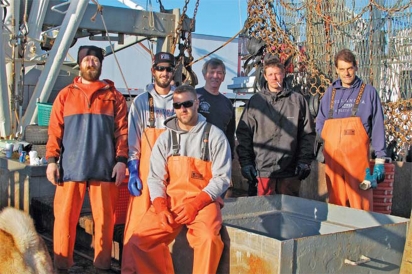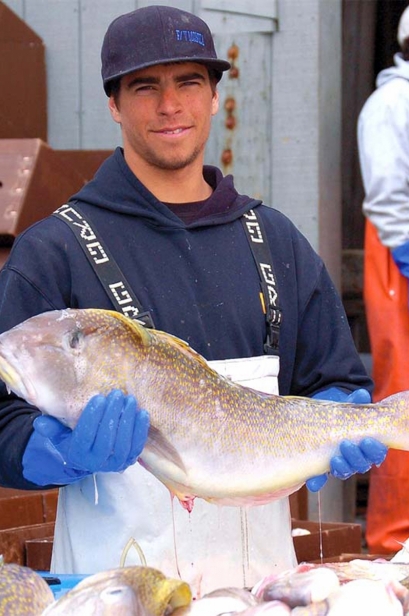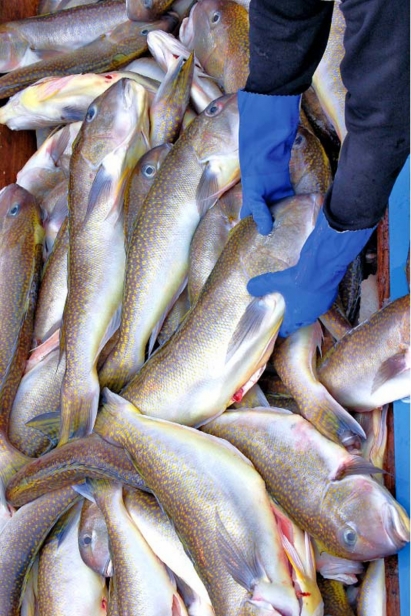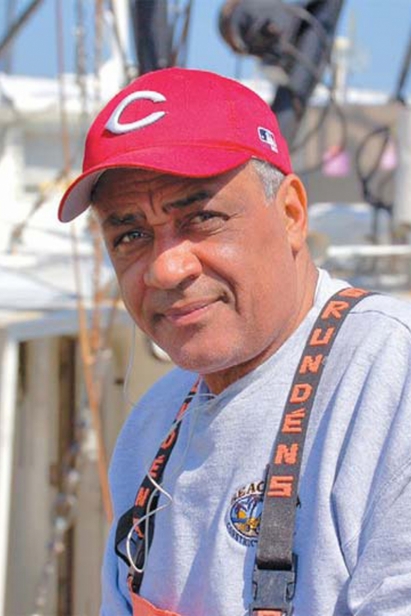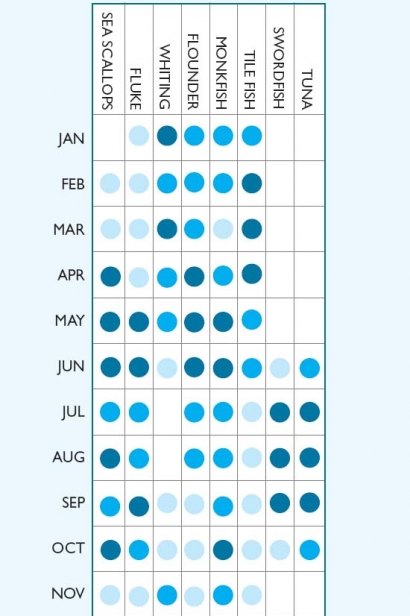Meet Jersey's Fishermen
Working on the Water
New Jersey comes in seventh (after Alaska, Massachusetts, Maine, Louisiana, Washington and Texas) in a ranking of states by the value of their commercial catch. In 2011, New Jersey commercial fishermen unloaded fish and shellfish worth more than $220 million at docks in Point Pleasant, Barnegat Light, Cape May and elsewhere. Thanks to the growth of the local-food movement, many of us now know the face of a Garden State farmer. Few of us, however, have ever met one of the state's hard-working commercial fishermen.
According to the Atlantic Coastal Cooperative Statistics Program, there were 355 active commercial fishermen in New Jersey in 2012 – the number of boat owners and captains. Add in crewmen, and perhaps there are a couple thousand more. Other numbers confirm what's said on the docks and at port watering holes, namely, that the industry needs new blood to survive. The average age of mid-Atlantic commercial fishermen is 53 years old.
In the pages ahead, you'll meet three New Jersey boat captains – two veterans and a youngster – who share stories about the work and life of one of the world's oldest professions.
ARTHUR OCHSE, Captain of the Christian & Alexa, Point Pleasant
Arthur Ochse, 63, has spent a half-century on the water. He worked party boats out of Shark River in the summer as a young boy. After high school he bought a lobster boat. Ochse was in his first year of law school at Rutgers–Camden when it hit him: "I'm only doing this so I can afford to go fishing on weekends. Why don't I just not be a lawyer and go fishing?" He's been on the water year-round ever since. In the early 70s, he partnered with his younger brother, Kenny, initially net fishing for whiting, fluke and other species. And since 1976, the Ochses have made a very good living hauling up the most prized catch on the Eastern seaboard – scallops.
"We go for scallops anywhere from 15 miles out to the Georges Bank [between Cape Cod and Nova Scotia]. Thirty-five hours to steam out there, so 350 miles. We get them with shells as big as eight inches across."
As you'll hear on the docks if you care to ask, a significant part of the job of a commercial fisherman on the East Coast is following regulations from the National Marine Fisheries Service, an agency tasked with balancing the ability of fishermen to make a living each year with the need to ensure there are still fish left to be caught in the future. The regulations include rules on gear, where you can fish, when you can fish and how much you can catch.
"With the gear restriction and these other regulations, we don't overfish. This year we'll probably be about 50,000 pounds less. Am I okay with that? It's better to get a little less than nothing down the road."
In 2012, Ochse's boat netted more than 200,000 pounds of scallops, at an average dock price of $10 a pound. He thinks his scallop license, if he wished to sell it, would probably go for about $5 million. He estimates that there are perhaps three dozen full-time scallop boats on the East Coast.
"I like the life – it's challenging. When we go out, except for our communication devices, we're disconnecting. We're totally separated from the rest of society. We're out there on our own doing everything. It's a both physical and thinking job. We have mechanical issues. Fishing issues. There's a crew you have to deal with, personalities. And you have the weather and all the safety issues.
"No, I've never been scared out there," he adds. "Biggest seas? Thirty footers. I haven't had any serious injuries, just sprained ankles and stuff. Kenny either. We're careful. I mean, I've cut other people's fingers off running a winch when somebody put his hand in the wrong spot and got a finger or two chopped off. I was living in Manasquan the last time I did it. I got nicknamed the Manasquan Mangler."
And for leisure during long scalloping trips, which can last 10 days or longer?
"We bring fishing poles out. We'll fish for tuna. When we're rigged up properly we'll get them 120 pounds. We'll eat some on board, bring the rest home. We've never sold a tuna. It's my favorite meat. Scallops? Very close."
DANNY MEARS JR., Captain of the Monica, Barnegat Light
Danny Mears, 24, is a fourth-generation fisherman. At the age of 9 he started working as a mate on a six-passenger charter boat owned by his grandfather, Donny Mears, who, in his prime, bought the 72- foot Monica to go sword and tuna fishing on the Grand Banks off Newfoundland. Donny's son, Dan Mears Sr., took over the boat for monk and then tile fishing. Nowadays, Junior is generally at the helm. "My grandfather taught me most of what I know," Mears says. "He was a good teacher, a little hard on me. He made sure I was on time. Made sure I was always on my A-game, always doing the best job I could do. Last summer, I did my first trip. I'm sure my dad will do a couple this year, but the majority of the fishing I'm going to be captaining the boat."
Through the year, the crew of the Monica fishes for tilefish, swordfish, tuna and monkfish.
"A typical swordfish or tuna trip lasts between 14 and 16 days. We go to Georges Bank. I haven't fished in the Grand Banks yet, but I would like to. I hear the size of the fish there is unbelievable.
"Tile trips are generally shorter. Our last trip was seven days. I was out in Atlantis Canyon, about 60 miles east of the Hudson Canyon. We fish with a cable main line, which sinks to the bottom, where the tilefish are. We've got 150 two-foot-long leaders with hooks, all baited up with squid. As we're setting the line out, you take one hook at a time from the feed tray and clip it onto the main line. It can be pretty dangerous if you're not paying attention. Most guys have been hooked at least once. I've been hooked in my hand. I've never seen anyone get pulled overboard, but I've heard stories of guys getting ripped off the back of the boat.
"You get paid for small, medium and large – and large is the best price, but over 30 pounds they're considered jumbos, and you tend to lose a little value when they get that big, so we're not really trying to target those bigger fish. We're looking for more like seven- to 30-pound fish really. In a good market, smalls probably go for $2.50, versus $4.50 for the large. It's a big difference if you're talking 10,000 to 20,000 pounds. It helps cover your expenses, like fuel at $3.75 a gallon. Last tile trip we burned 1,300 gallons."
Mears' small crew consists of two guys he went to high school with, friends he trained, and a fisherman who's worked with his dad for about 12 years. "I know maybe one or two captains who are maybe a couple years older than me," he says. "Other than that, it's mostly a lot of older guys doing it.
"Quotas? I think quotas are really good because it's all about sustainability," he says. "Young guys like me, we want to keep fishing. I think the way we're being regulated now, the problem is being fixed and it's a matter of time before they say, hey, these guys can have more. The quotas are getting raised for a lot of the fisheries."
The excitement of landing a large swordfish or tuna is still one of the best moments of the job. "When you get a sword or tuna on the line you can actually feel the fish a couple hundred feet before you even get to the leader. You have to start maneuvering the boat to get the leader up to your hands, and you connect that leader onto a live line and then you have to fight the fish by hand. Sometimes it will take over an hour to land a single fish. It's an adrenaline rush. Every once in a while you'll catch a giant, and it will pull all of your line out of the basket and what you do is connect buoys to the end of the line, and you let the buoys out, and go pick the buoys up. We've caught 500-pound and 600-pound swordfish."
MANUEL VIANA, Captain of the Jaime Mae, Point Pleasant
Manuel Viana, 53, was born in Portugal. All his relatives there are fishermen. As a teenager, he fished weekends on Jersey party boats. He lasted one year in college. He's been fishing for a living ever since.
"The Jaime Mae is named for the owner's daughters," Viana says. "I've been with him 27 years. All year round I fish for fluke. May 1, I can go blackback flounder fishing and for scallops. And in July, I catch whiting and squid, which also have quotas.
"There's usually three of us on the boat, except in summer with fluke. It's not that much work for 500 pounds of fluke for the day. We leave the dock at 3am and are usually back at 2 or 3 in the afternoon. In summer, only two guys go out, so every third day you're off. That way you get to enjoy a little bit of the summer with your grandkids."
Viana says that since he started fishing in 1979, the size requirement for keeping fish has steadily increased, another regulation meant to help replenish fish populations. "For instance, with fluke, they used to have to be 11 inches; now it's 14 inches. It used to be 11-inch flounder. It's 13 inches now. Sea bass was whatever you wanted to bring in. Now they have to be 12 inches. Porgies have to be seven inches now. We used to bring in anything we wanted. Codfish is 21 inches, as opposed to no size."
Like most fishermen, commercial fishermen have their favorite spots, though technology now helps confirm or refute their hunches.
"I fish a lot of the same spots I've always fished for certain species," Viana says. "A mudhole is a ditch that was created by glaciers, like the one that came down the Hudson Valley and went all the way out to the continental shelf. Since 1975, when I was on a party boat, we always fished the edge of the mudhole for whiting. Nowadays, it's all GPS. It's a lot more accurate. And our radars are better – you don't have to stick your head into a cone like they used to. If there was any glare, you couldn't see the screen in the old days. That's when they had a beam of light that went around and when it hit something it went, beep . . . beep. Well, nowadays, there's a full screen right there. It will show you the beach, every buoy, and it goes 54 miles. I can see the entrance to New York Harbor sitting at the dock. It's a lot better.
"I can't say I have a favorite catch," Viana concludes. "Personally, I like it all, because that's what my life is all about. I get up in the morning to go catch fish, and I catch fish so I can pay my bills, so I can have a good life with my wife and my dog. My kids are grown up. But also I have pride to bring in a good product, and I know I'm supplying restaurants, senior citizens, children, moms, dads. For me, moneywise, it's scallops. You get scallops, you get a paycheck and a half. And with scallops, they're always in that area. I can leave in the morning and know I'm going to get scallops. Fluke, you have to look for them. When the net comes up you never know what's going to be in there. You can put in a whole day and the sun will be going down and you'll say on the radio: 'Well, I'm still here. I don't know how long I'm going to be here.' Some days, though, I'll go on the radio and say, 'Home run. I'm outta here.'"
Like most fishermen, commercial fishermen have their favorite spots, though technology now helps confi rm or refute their hunches. “I fish a lot of the same spots I’ve always fi shed for certain species,” Viana says. “A mudhole is a ditch that was created by glaciers, like the one that came down the Hudson Valley and went all the way out to the continental shelf. Since 1975, when I was on a party boat, we always fi shed the edge of the mudhole for whiting. Nowadays, it’s all GPS. It’s a lot more accurate. And our radars are better—you don’t have to stick your head into a cone like they used to. If there was any glare, you couldn’t see the screen in the old days. That’s when they had a beam of light that went around and when it hit something it went, beep … beep. Well, nowadays, there’s a full screen right there. It will show you the beach, every buoy, and it goes 54 miles. I can see the entrance to New York Harbor sitting at the dock. It’s a lot better.
“I can’t say I have a favorite catch,” Viana concludes. “Personally, I like it all, because that’s what my life is all about. I get up in the morning to go catch fish, and I catch fish so I can pay my bills, so I can have a good life with my wife and my dog. My kids are grown up. But also I have pride to bring in a good product, and I know I’m supplying restaurants, senior citizens, children, moms, dads. For me, moneywise, it’s scallops. You get scallops, you get a paycheck and a half. And with scallops, they’re always in that area. I can leave in the morning and know I’m going to get scallops. Fluke, you have to look for them. When the net comes up you never know what’s going to be in there. You can put in a whole day and the sun will be going down and you’ll say on the radio: ‘Well, I’m still here. I don’t know how long I’m going to be here.’ Some days, though, I’ll go on the radio and say, ‘Home run. I’m outta here.’”






